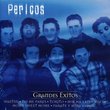| All Artists: After the Burial Title: Forging a Future Self Members Wishing: 2 Total Copies: 0 Label: Corrosive Recordings Original Release Date: 1/1/2007 Re-Release Date: 1/9/2007 Genres: Alternative Rock, Rock, Metal Styles: Hardcore & Punk, Progressive, Progressive Metal, Death Metal Number of Discs: 1 SwapaCD Credits: 1 UPC: 643157377931 |
Search - After the Burial :: Forging a Future Self
 | After the Burial Forging a Future Self Genres: Alternative Rock, Rock, Metal
After The Burial formed in September 2004 and began creating a unique blend of Metal combining off time poly-rythyms, heartfelt melody, and overall intensely heavy guitar work. Each song is a carefully constructed piece ... more » |
Larger Image |
CD DetailsSynopsis
Album Description After The Burial formed in September 2004 and began creating a unique blend of Metal combining off time poly-rythyms, heartfelt melody, and overall intensely heavy guitar work. Each song is a carefully constructed piece and their live show is just as intense and energetic as their music. After a year of hard work things really started to take off. They released their self produced debut "Forging A Future Self", and have revived Metal's presence in the Twin Cities. They were one of the very few unsigned acts at Robot Mosh Fest 2006 playing alongside Animosity, Job for a Cowboy, Misery Index and Dead to Fall. "Forging A Future Self is powerful throughout its entire length. What's really interesting about this album is that the whole thing is incredibly catchy and never succumbs to pressures to be overly technical or set on mosh parts. The band stays complex but not to the point of numbing listeners' minds". - geekburger.com Similar CDs
|
CD ReviewsMath Metal? Zaksam | Birmingham, AL | 08/08/2008 (4 out of 5 stars) "After The Burial are smart fellows. They even know their math! The following is an explanation of the writing process for their song "Pi":
Pi was written and recorded only a few days before the completion of the Master copy, at around 10 am, with a couple of serious hangovers. Justin and I had talked about having a classical guitar intro into some sort of heavier riffage, but we weren't quite sure what that was exactly going to be. We remembered back to a few weeks prior, when we were throwing around an idea of using the mathematical constant Pi, and incorporating it into some sort of complex breakdown pattern where the kick drum corresponded to each number as the figure progressed. Kinda creating the ultimate mind boggler of a riff. The complexity of the intro is often overheard, because it's hard to discern what is actually going on within the track, UNTIL NOW!! Here's a breakdown of the....um, breakdown, in the intro to our album, "Pi: The Mercury God Of Infinity" The actual tempo is 120 beats per minute (bpm). You can hear this by listening for the closed hi-hat that is panned left: it is playing constant eighth-notes. The snare is on beat three in 4/4 time at 120 bpm. A crash cymbal accents beat one of the first measure in 4/4. It is repeated every four measures. Now this is where it gets tricky: the china cymbal. It's hard to feel the breakdown in Pi at 120 bpm, and this is mostly due to the china cymbal, which is playing a 4 over 3 (4/3) dotted-eighth note ostinato that begins on the "E" of one. Confused? Check it out: A quarter note is equal to one beat in 4/4 time, but so are two eighth notes, or 4 sixteenth notes. It's all about subdividing note values. When you count a measure of 4/4 in quarter notes, it's: 1, 2, 3, 4. When counting in eighth notes, it's: 1 + 2 + 3 + 4 +. (a plus sign refers to the spoken count "and" ex. "One and two and three and four and") When counting in sixteenths, it's: 1 E + A 2 E + A 3 E + A 4 E + A. (Spoken: "One e and a two e and a three e and a four e and a) So when I say the china starts on the "E" of one, I'm referring to the spoken counting value assigned to the second 16th note in a quarter note duration. A dotted eighth note is a duration of three 16th notes, an ostinato is a persistently repeated pattern. Basically, the china plays on the bold-capitalized letters: one E and a TWO e and A three e AND a four E and a ONE e and A etc. Starting to get it? Cool. At last, the reason Pi is what it is: the Double-bass pattern. The formula of Pi for the kick drum was pretty far fetched at first, but seemed to work well once the track was finished. The numbers and rests in the formula translate to 16th notes on the kick drum, and 16th note rests. There is no kick drum beats where there are snare drums. Sooo, here it is: With the decimal point BEFORE the number, and starting with the first number, move that many decimal points to the right and insert that many 16th note rests. Use one 16th note rest to divide the numbers you passed (when applicable). Continue on throughout the rest of the figure. No repeats. So basically for the first step, you'd place the point (pt) before the first number, three: (pt)3.14159265 Next you jump the decimal three points to the right: 3.14(pt)159265 That's where you insert three 16th rests, and insert one 16th note rest between the other numbers you passed: 3(16th rest)1(16th rest)4(dotted-eighth)159265 Now, your decimal lies in between the 4 and the 1. So, following the formula, you move one point to the right of the 1 and insert one 16th note rest. There are no numbers to separate with single 16th rests, so you move onto the next number, which is 5, and follow the same instructions. That's all there is to it! The formula extends out to 71 decimal points." |

 Track Listings (9) - Disc #1
Track Listings (9) - Disc #1
